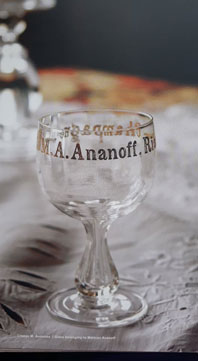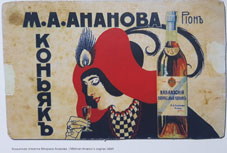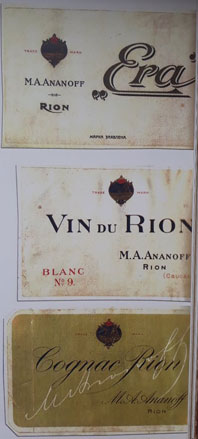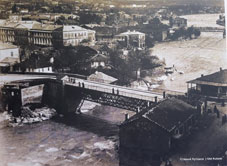
Mikhran Ananov - Country of Liquid Sun
Friday, May 8
The Ananov brothers purchased the Ajameti oak forest and plough grounds in the village of Vartsikhe of the Kutaisi region in the 1860s. Before then, the forest and its grounds were considered as a part of the princely estate. This place, where the River Khvirila flows into the River Rioni, was approximately 15 versts away from Kutaisi. In 1888, Ivane Ananov died and the affairs of exploitation of Vartsikhe estates and the Ajameti forests were continued by his grandsons, Abgar and Mikhran.
In addition to the vineyards, wine cellar and residential palace, the Ananovs also owned other facilities. They possessed vast forest massifs in Ajameti which were known for zelkova trees providing very expensive wood material. The Caucasian Railway was under construction at that time with the Ananovs supplying material for the wooden sleepers required for the laying of the rails for which they earned great income. The trees were cut intensely with the logged wood prepared as material for sleepers and carried out of the forest by buffalos supplingsupplying draft labour. According to the officials of the time, Ananov and General Mirsky arranged for the building of the road which bypassed the city of Kutaisi. Mirsky owned large estatets in and around Ananov's properties.
Mikhran Ananov continued producing wine and, again and again, enlarged the vineyards based upon generated income. In addition to the local varieties, he cultivated champagne species, brought from France; namely, the Pinot, Aligote, Semillon and Cognac variety of Fonblan At the end of the nineteenth century. Ananov brought Charant equipment for cognac distillation from France and installed it near Vartsikhe at his estate, Apkhanauri. The equipment was operated by French specialists, and since 1905, the technological processed were managed by Giorgi Kepuladze, a noted specialist, who worked at the Vartsikhe factory for his whole life.
Over 300 workers were employed at Ananov's farm with the workers calling Mikhran the "Great Agha. His estates were managed by Sarkis lonesiants, an Armenian from Karabakh, who had two Armenian assistants alongside. Most of the hired employees were from the regions of Guria and Samegrelo with the bullock-cart drivers mostly coming from Kartli.
The workers were divided into three categories; namely, those on daily, monthly and annual remuneration schedules. Daily workers were very poor. They were paid 20 copecks, received one corn loaf and some beans as their daily ration and lived in poor conditions with many having succumbed to fever. Annual workers, by contrast, had much better working and living conditions.
The "Great Agha,” riding a beautiful Larabakh horse (the 12 best horses were found in Ananov's stable), used to go around the estates together with Sarkis and often inquired about the conditions of the employees as illness was frequent and making many of them weak and infirm. Ananov, who looked very much like a Georgian prince, spoke Georgian as his mother tongue and talked with the employees and local peasants only in the Georgian language.
The growth of the size of the vineyards owned by Ananov conditioned the construction of a winery. Mikhran visited a champagne factory owned by Prince Oldenburgsky in Kutaisi and invited specialists whom he ordered to develop the engineering design of the winery in Vartsikhe.
The Vartsikhe winery began operation in 1907. The Georgian Tsolikauri Brand of wine was first made in the Varstikhe Factory. Vakhtang Tsitsishvili, a noted specialist, created the famous Georgian cognac, Vartsikhe, only upon the basis of spirits distilled from the wine material at the factory.
After Georgia's becoming a Soviet Republic, the Ananovs emigrated to Austria and their magnificent palace was turned into a kindergarten. Presently, a hotel operates there. The factory in Vartsikhe, which almost never stopped in its operation, together with one of the larger farms, became part of the Peoples' Estate's Trust, the so-called "Samtrest."






